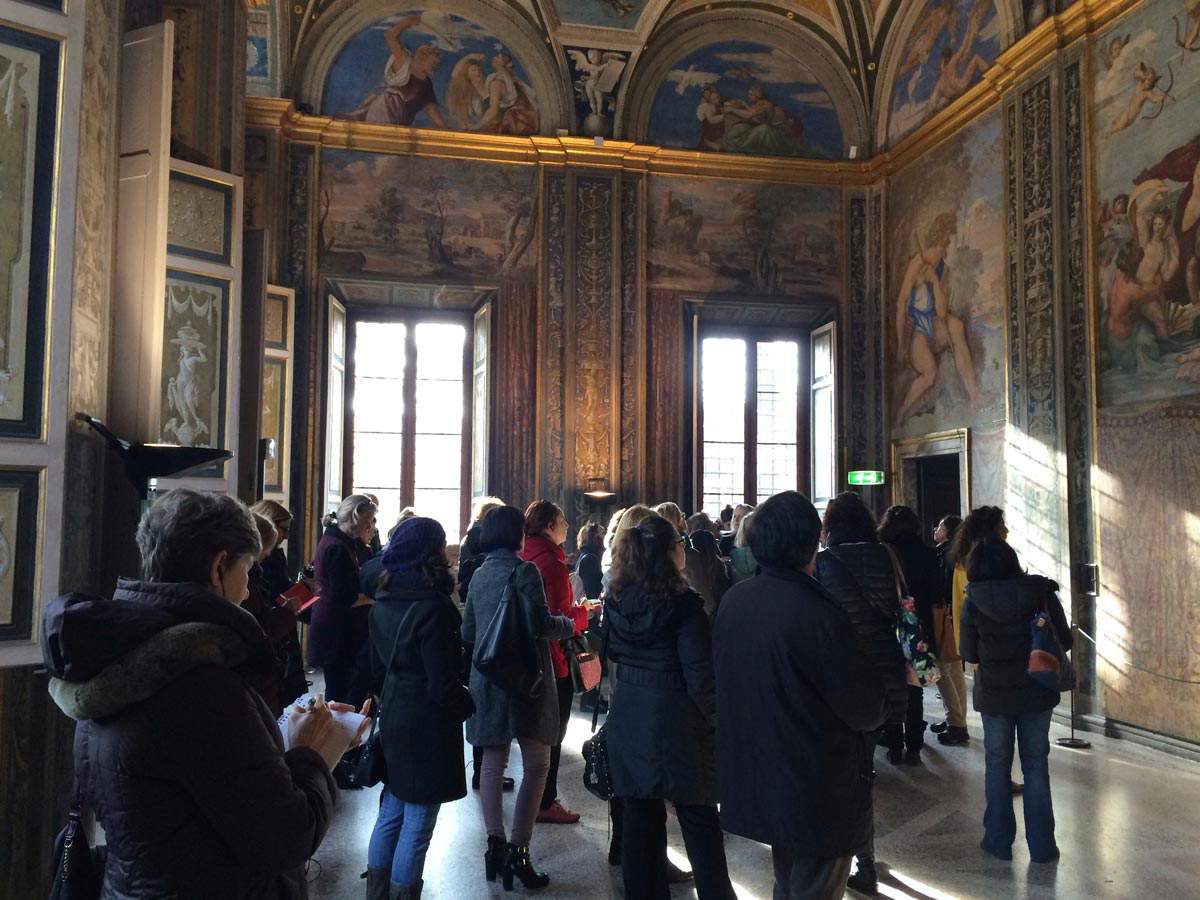In the Middle Ages it was cats and witches, now it is tour guides; who are in fact for the vast majority women who are afraid of the virus. In fact, judging by the current regulations, they are considered dangerous to everyone around, because sightseeing is among the few activities still now banned in various places in Italy. Despite the use of face masks and microphones with earphones and despite the distancing, tours are looked upon in the world of cultural heritage as one of the most dangerous means of transmission of the virus. There are also rumors that guides would be blamed for creating gatherings by unions of janitors working in museums and monuments, even those in outdoor archaeological parks.
However, we wonder if the “virus” and health protection are not being used for other purposes. There are wonderful sites where explanations can no longer be given and guided tours are completely prohibited: Villa Farnesina in Rome, Galleria Borghese in Rome, Palazzo Barberini in Rome, Galleria Corsini in Rome In so many places explanations can be given to an extremely small number of people.
 |
| Female visitor to the Borghese Gallery |
At Sant’Apollinare in Classe in Ravenna, the most visited site in Emilia Romagna, despite the size of the basilica, guides can enter with a maximum of 8 people. In Florence, at the Accademia and the National Archaeological Museum, with 5. The limitations, however, do not spare even the outdoor archaeological parks. Inexplicably, in Herculaneum a guide can lead a maximum of 10 people, while in Pompeii and Ostia up to 25 (provided they have earphones). A group of 25 people, if they want to visit Pompeii and Herculaneum, must split up and take 3 guides at Herculaneum. Even more serious is the case of sites where only internal guides can explain: Castel Del Monte, Sacro Speco in Subiaco (Saturday and Sunday only internal guides, external guides can explain only Monday through Friday)
Given the variety of museum buildings and monuments, MIBACT can only give general directions, and each director must decide the rules independently, based on the specific spaces and characteristics of each facility. The antiquity and type of buildings in which so many Italian museums are housed makes it difficult to adapt them to the required health regulations. Therefore, we are well aware of the difficulties that each institution has faced in reopening; and we sympathize with the directors and officials of all the cultural sites who are facing enormous problems, both security and financial, at this time.
We are familiar, however, with the monuments we are talking about. We therefore contest that in a building like the Farnesina (which was already almost always empty in previous years, when Rome had the problem ofovertourism, because it is one of those little-known treasures that is a destination for a few enthusiasts and that now, without foreign tourists, is even more desolately deserted) guided tours with 5-10 people are impossible safely even in the largest halls.
 |
| Empty Borghese Gallery hall in Covid period |
We think that in museums where tours are now totally banned the problem would be solvable by allowing explanations in the larger rooms and banning them in those too small. Everything can be solved, if approached in the right spirit.
The worst case, however, is that of sites where guides have been banned altogether, using health regulations from COVID-19 as an excuse.
Castel Del Monte in Puglia is currently the most egregious example: since the day it reopened on July 1, entrances have been limited to one shift per hour and guided tours are restricted to concessionaire staff only, while all other guides are prohibited from practicing their profession inside the monument. These are choices that are not justified by health regulations: the obligatory itineraries, limited time and flows can be perfectly combined with “outside” guides and multiple shifts.
The phenomenon is spreading dangerously. Also in Lazio, at the Sacro Speco, on Saturdays and Sundays, the days when more visitors arrive, visits are reserved for people chosen and coordinated by the religious structure.
 |
| Visitors to the Farnesina in the pre-Covid period. |
The problem of the exclusion of guides from the sites goes back a few years, and the situation has particularly worsened since 2015. Our associations AGTAR and AGTA have been fighting on this front for quite a while and have had to face the wall put up by the likes of the Museum of Civilizations (with Pigorini) and even the Quirinale.
Evidently, internal visits “appeal” to many stakeholders in the field.
Every time there is a good pretext to give exclusivity: from the need for free tours to controlling content, from free Sundays to lack of staff, we have heard all the reasons. We knew that, past the lockdown, we would also be fed the coronavirus one: how not to use it? It’s perfect: you start the sentence with “public health, regulations, limitations, quotas” and end with “visits are restricted to internal staff only,” of course adding that “this is a temporary rule” to calm tempers.
What about us, can we “temporarily” not pay taxes and burn the certification that is no longer needed to work anywhere?
Warning: the translation into English of the original Italian article was created using automatic tools. We undertake to review all articles, but we do not guarantee the total absence of inaccuracies in the translation due to the program. You can find the original by clicking on the ITA button. If you find any mistake,please contact us.